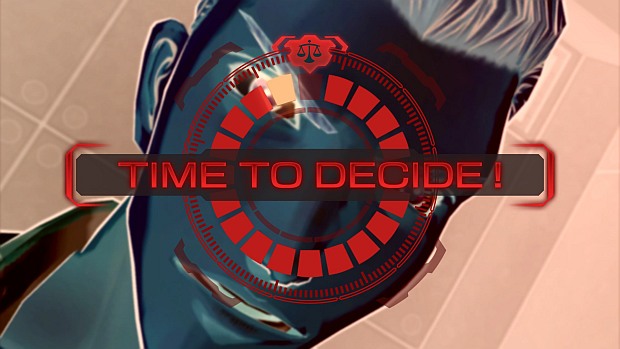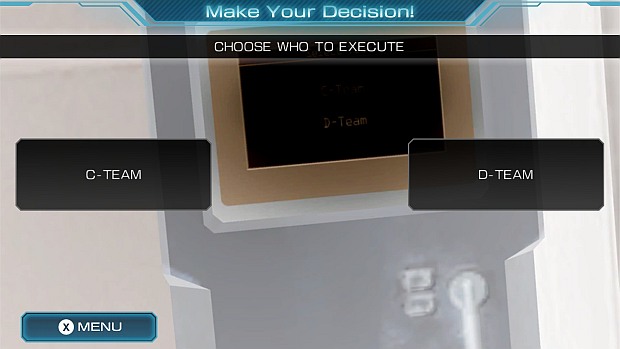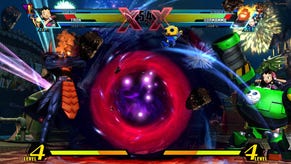Wot I Think: Zero Escape: Zero Time Dilemma
Time to decide!
Flip a coin. If it’s heads, carry on. If it’s tails, embark upon a 20-hour adventure in which you might be cut in half with a chainsaw, dissolved in acid, or turned into nuclear goop in a big uranium-fuelled explosion.
This is the first and most central decision of visual novel/room escape game Zero Escape: Zero Time Dilemma. Nine people are trapped in a facility, and six people must die in order to reveal the six passwords for the exit. What’s more, every 90 minutes, everyone is put to sleep and their memories are wiped, which - as you might imagine - makes everything terribly confusing to piece together, for both them and you.
As the third game in the Zero Escape trilogy, Zero Time Dilemma plays on a similar concept to its prequels, Nine Hours, Nine Persons, Nine Doors and Virtue’s Last Reward: the story takes place on a branching flowchart, splitting whenever you have to make a decision.
In 999, this was as simple as choosing one of two doors to go through. In VLR, it was slightly more complicated - each team would vote every couple of hours to ally or betray the others in order to maximise their own chances of escape. It’s yet again more complicated in Zero Time Dilemma, as you take part in the “Decision Game”. Your mysterious antagonist, Zero, puts you in situations requiring (usually) a binary choice at the end - push the button or not; save person A or person B; betray team A or save them? It’s a different way of telling the story to previous games, but your decisions have more immediate consequences than just choosing a door.
However, those immediate consequences are not always that interesting in themselves. If you’ve played 999 or VLR, you’ll know that every ending has to be seen before progress can be made, due to the way the narrative-hopping story plays out, but Zero Time Dilemma will just tell you “...and then X died. GAME OVER” and boot you back to the selection screen to choose a more eventful branch. Because you have to play out each bad ending to find the good one - and to comprehend the full story - this can feel a bit more like box-ticking than actual progress.
However, when the narrative branches delve into the secrets and motivations of a character, that’s when Zero Time Dilemma shines. Not all of the characters are as interesting as past games - in particular, newcomers Eric and Mira are weirdly one-dimensional, the former as an overprotective fool and the latter as a distractingly chesty psychopath - but seeing what happens with Phi and Sigma, recurring characters from the previous game, is compelling enough to make you want to play Virtue’s Last Reward again with fresh eyes.
Unfortunately, the game is marred by visual issues. Over-enthusiastic hair and breast physics make it hard to take a scene seriously as Mira’s generous bosom bounces merrily in the background and Akane’s hair attempts to perform a Riverdance routine on the back of her head. What’s even worse is the 3D animation, a new addition to the Zero Escape series.
The characters’ movements are sharp, stiff and robotic, like animatronic puppets with rusted joints. Their facial expressions are locked into something between anger and indifference, with everyone having the kind of sharp, angular eyebrows you’d see in a heavily stylised anime. More complicated animations are bypassed altogether as the camera cuts to a view of the ceiling. If this was used sparsely, it might seem cinematic; as it is, the camera cuts to the same ceiling view about five times in every story segment.
Zero Time Dilemma is still a visual novel and an escape-the-room game at its heart, and when it focuses on those aspects, it’s almost as excellent as its prequels. It does suffer from similar problems - getting too caught up in its own confusing philosophical monologues, relying too much on the player’s knowledge of what happened in the two previous games, and beginning the story in media res and expecting the player to piece it together themselves - but the story itself, once you understand what’s going on, is impressively smart, thoughtful and gripping.
The narrative unfolds in whatever order you choose, as you make your decisions, opening up new branches of the flowchart and attempting to create a coherent timeline of events in your head. It’s not until the very end of the game that you really understand any of what’s happened, and there are some deliciously juicy twists that will (hopefully) genuinely take you by surprise.
The escape-the-room segments, which vary between engaging puzzles and irritatingly difficult leaps of logic, are disappointingly few and far between. Zero Time Dilemma isn’t really about the rooms as much as it is about the people, and where 999 used the rooms and the puzzles and objects within to reveal parts of each character, Zero Time Dilemma instead bookends the escaping part with more story. It’s a shame they aren’t more integrated, and it’s also a shame to miss out on the bits that work well with the 3DS’ stylus, like note-taking.
There is a lot to love about Zero Time Dilemma, though its weird new look is a clear misstep in a series that’s otherwise managed to be quite stylish with the limited resources it had. If you are a fan of 999 and VLR, it’s a must-play to fill in the gaps between the two - and you’ll appreciate the twists and reveals more than anyone else. The occasionally dull new characters are mostly redeemed by their motivations and backstories in the end, but it’s hard to overlook Zero Time Dilemma’s visual flaws, which distract from the brilliance of the story. It’s by no means the best Zero Escape game, but it’s a fitting end to the trilogy’s story arc and - animation aside - it’s an excellent way to spend a few evenings.
Zero Escape: Zero Time Dilemma is out now for Windows via Steam for £30/$40/€37.





















